Carl Zeiss Jena monokularer Feldstecher Vergr.=6 |
Carl Zeiss Jena 6x monocular Field Glass |
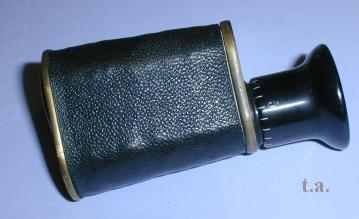
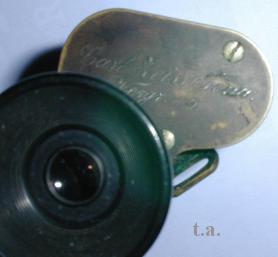
| Hier ist ein monokularer 6x18 Feldstecher mit geradem Deckel und dem Handschrift-Logo "Carl Zeiss, Jena" plus "Vergr.=6". Die Seriennummer ist 36 bzw. 87 beim zweiten Modell. Es sind daher sehr frühe Exemplare aus dem Anfangsjahr der Serie in 1896 sowie 1898. Wie bei allen frühen Monokular-Modellen befindet sich die Seriennummer nahe am Okular neben einer Deckelschraube eingraviert. Die Deckel sind dreifach verschraubt, aus Messing und schwarz lackiert. Der untere Deckel hat als Besonderheit ein viertes leeres Schraubloch nahe dem Objektiv, dessen Schraube zur Arrtierung des Objektivfassung diente. Das Prismengehäuse hat eine dunkelbraune Lederummantelung und einen aufgeschraubten Metallstreifen mit Trageriemenöse. Dieser geht über die ganze Korpuslänge. Das linksseitige Okular hat eine 3/3 Bakelitaugenmuschel. Die Objektivlinse liegt ca. 12 mm nach innen zurück versetzt in der leicht konsichen Objektivfassung als Blendschutz. |
Here is a monocular 6x18 Field-Glass (Feldstecher) with flat prism covers and the handscript logo "Carl Zeiss, Jena" plus "Vergr.=6" (magnification = 6). It has the serial number 36, and 87 respectively for the second model. Hence these specimen must date from the beginning of the model series in 1896, and 1898. The serial number is engraved near the ocular and one of the screws as usual for the early monocular models. The cover plates have three screws, are made of brass, and are painted black. The lower cover plate features an empty fourth screw hole close to the objective. The screw there was meant to fix the objective frame. The prism housing has a dark brown leather covering and a screwed on metal strip with the strap lug. The metal strip fully covers the body height. The left-hand sided ocular has a 3/3 Bakelite eyecup. The objective lens is recessed by 1cm into its slightly conical frame to function as a ray-shade. |
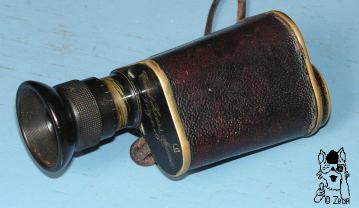
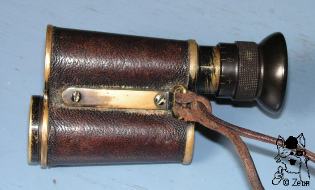
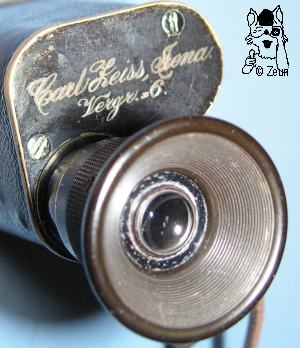
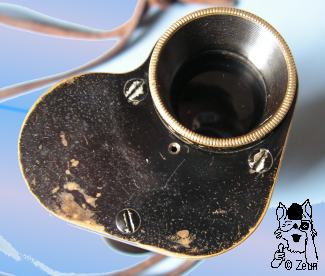
| Das Monokular ist 8,4 - 9,4cm lang. Das Gehäuse ist oben 39x39mm und unten 44x44mm breit und 60mm hoch. Die Objektivfassung ist 25mm, die Augenmuschel 32mm, das Okularstück 19mm im Durchmesser. Das Monokular wiegt 149g. | The monocular measures 8.4 - 9.4cm in length. The housing is 39x39mm at its top, and 44x44mm at its bottom. It is 60mm tall. The objective frame is 25mm in diameter, the eyecip 32mm, and the eyepiece 19mm in diameter. The glass weighs 149g. |
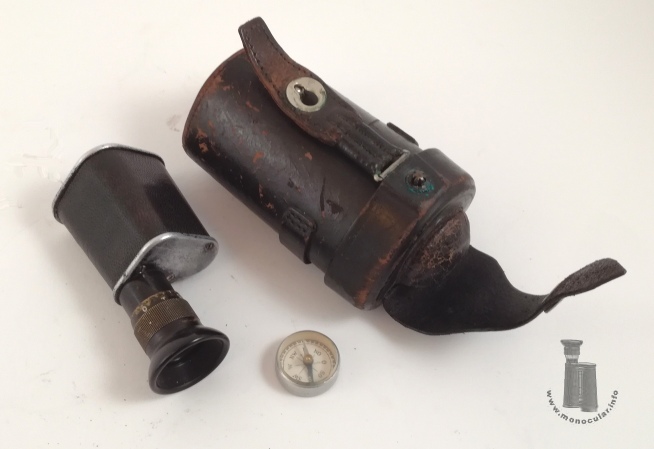
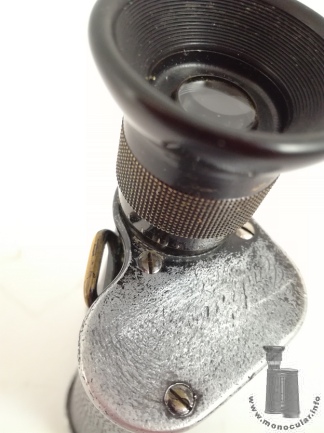
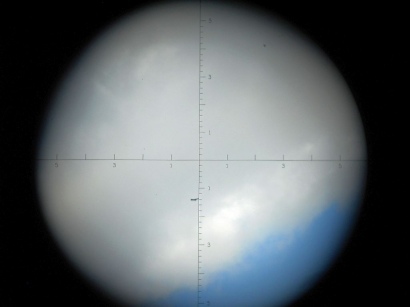
| Ein etwas späteres Modell - evtl. zwischen 1900 und 1904 - mit Seriennummer 152 und kaum noch lesbarer floraler Gravur auf dem blanken Messigndeckel hat bereits nur eine 1/3 Hartgummi-Augenmuschel sowie separat den kreuz-geriffelten Fokussierungsring und einen Dioptrienring mit komplett umlaufender Skala (markiert bei 0 und +/-5) am linksseitigen Okularstück. Die Objektivfassung ist nur 23 mm im Durchmesser und deren nach innen zurück versetzen gegen Streulicht geriffelten Wände sind gerade. Okularstück und Objektivhülse werden durch eine Deckelrandschraube fixiert. Als Besonderheit hat das 6x eine Fadenkreuzstrichplatte mit einer Skaleneinteilung von 1 - 5 an allen Strichen vom Zentrum aus; darüberhinaus ist auf dem Köcherdeckel ein zusätzliches Lederfach für einen herausnehmbaren kleinen Kompass aufgenägt. Der Kompass ist aus Blech und eienr Sichtglasscheibe, er misst 26 mm im Durchmesser und ist 10 mm dick bzw. hoch. Das Kompassfach selbst kann wiederum mit einer Lederlasche abgedeckt und per Drucknopf am Köcherdeckelrand verschlossen werden. (Vgl. Fernglasmuseum.at) | A later model - probably between 1900 to 1904 - with the serial number 152 and an almost unreadable floral engraving on the polished aluminium cover plate comes with a 1/3 Ebonite eyecup and separately with the + knurled focusing ring and a dioptre ring with a full scale marked at zero and +/-5 on its left-hand-sided eyepiece. The objective frame is only 23 mm in diameter and its recessed knurled walls preventing stray-light are straight. The eyepiece and the opbejctive frame are fixed by cover rim screws. A special feature is the cross-hairs reticle with a scale from 1 to 5 beginning at the centre on all 4 lines; moreover, on the case's lid there is a sewed-on leather compartment holding a small compass. The compass is made of tin and a glass disc, and measures 26 mm in diameter and is 10 mm high or thick. The compartmnent itself can again be covered with a leather flap and closed by means of a push button on the rim of the lid. (cf. fernglasmuseum.at) |
Fotos: 1-2 T.Antoniades; 3-9 Zeun; 10 H. Leichtfried.

